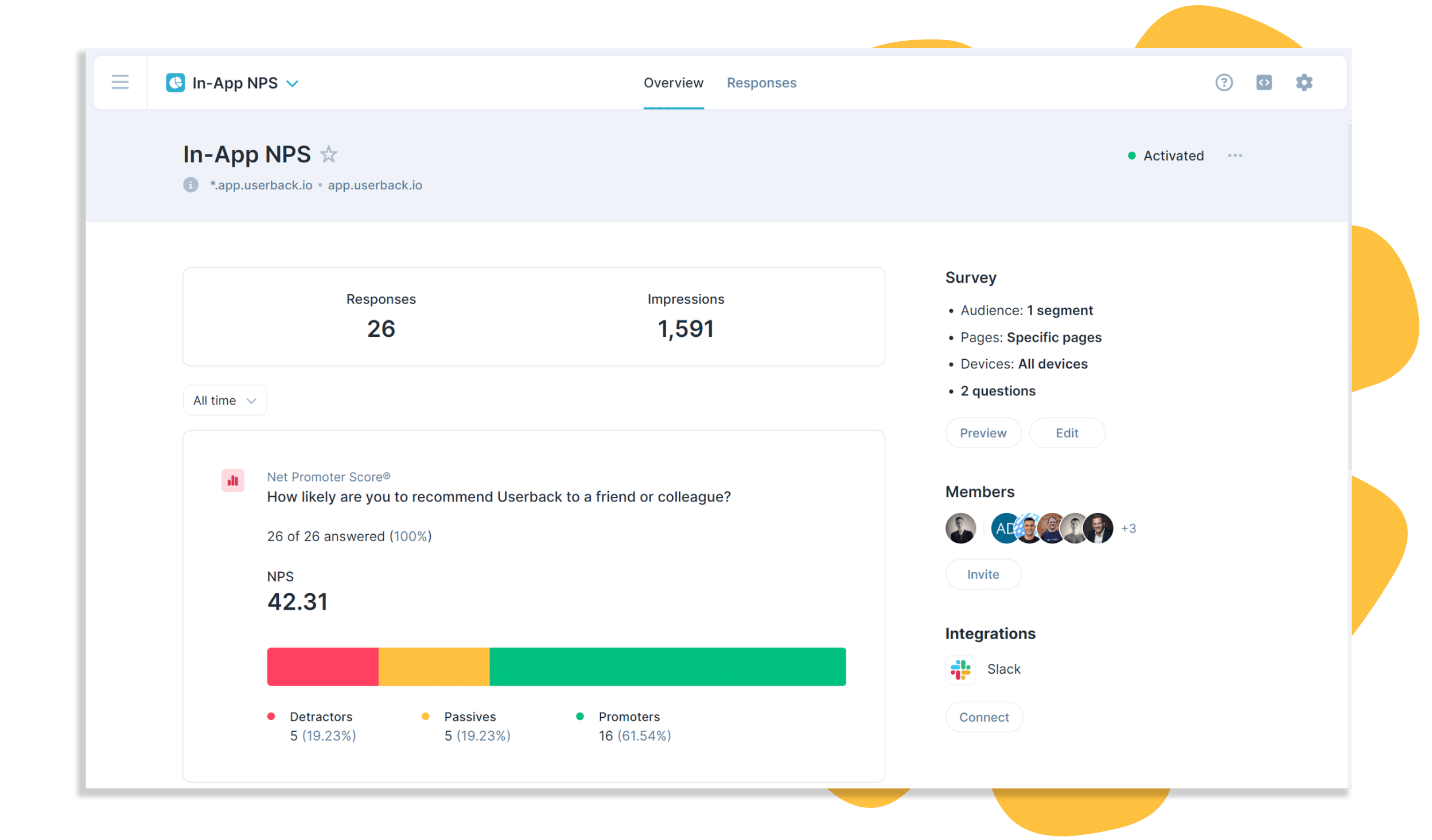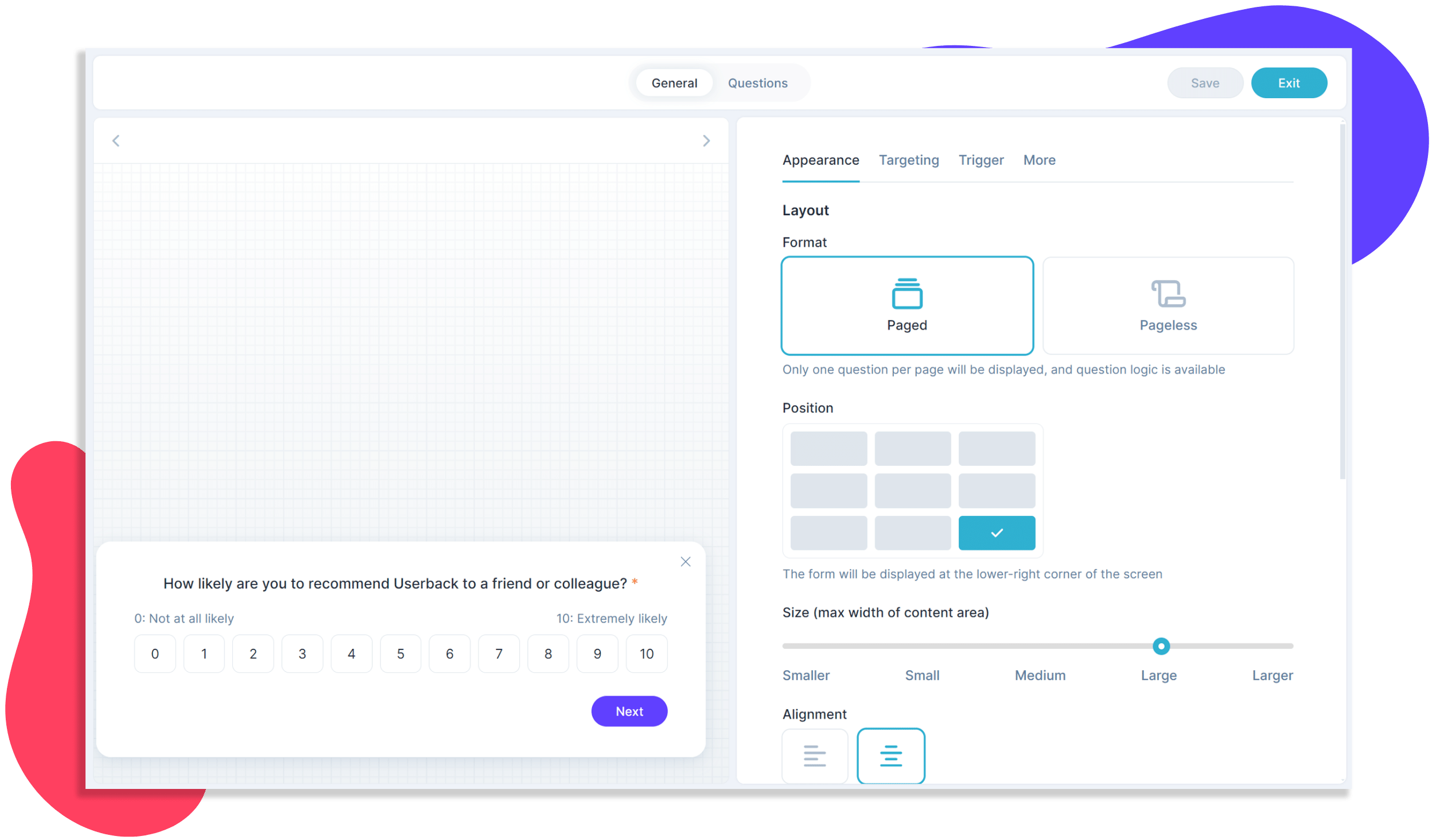
Wondering how to calculate NPS? We’re not surprised. In the realm of customer satisfaction metrics, few tools wield the power of simplicity and insight quite like the Net Promoter Score (NPS). For product managers and SaaS organizations, NPS is more than just a numerical figure—it’s a compass pointing to your customer’s loyalty and their proclivity to spread the word about your brand.
The NPS methodology is a critical component of understanding how your audience perceives your product and is an invaluable guide when steering your company’s course to growth and retention strategies.
Let’s dive into the nuances of NPS, from unravelling its calculation to translating the results into actionable improvement plans for your offerings. This comprehensive guide is designed to equip you with the knowledge to harness the power of NPS in your quest for customer-centric excellence.
What is NPS?
The Net Promoter Score is a management tool developed by Fred Reichheld, Bain & Company, and Satmetrix. It was introduced with the claim that it could predict customer satisfaction and loyalty more accurately than traditional customer satisfaction surveys.
The NPS quantifies the willingness of customers to recommend a company’s products or services to others. With a scale of 0 to 10, customers are categorized as Promoters (score 9-10), Passives (score 7-8), or Detractors (score 0-6). The NPS is then calculated by subtracting the percentage of Detractors from the percentage of Promoters.
Why Learn How to Calculate NPS?
The NPS does more than just provide you with a snapshot of customer sentiment. Understanding net promoter score can yield significant benefits, including:
Actionable Insights: It distils customer feedback into a single, simple, powerful number.
Long-term growth prediction: Studies have found a correlation between high NPS scores and revenue growth.
Improvement Roadmap: NPS responses offer guidance on how to improve your proposition.
Benchmarking: Allows comparison to industry standards and competitors.

How to Calculate NPS
The process of how to calculate NPS might seem straightforward, but executing it effectively requires precision and strategy.
Survey Design and Distribution
Your NPS survey should be clear, concise, and focused on a single question: “How likely is it that you would recommend [your brand] to a friend or colleague?” Respondents can provide their ratings and typically have an open field to explain their score, which can provide rich qualitative insights.
Designing your survey is critical to collecting the right data. Remember, the guiding principle is to make the survey engaging and easy to complete.
Collecting and Analyzing Responses
To calculate NPS, you need to collect a statistically significant sample of customer responses. You can do this through various channels, such as email, embedded forms on your website, or with the aid of customer feedback platforms.
Analyzing the responses involves categorizing customers into Promoters, Passives, and Detractors based on their scores. Then, calculate the percentages each group represents.
Calculating the NPS Score
Subtract the percentage of Detractors from the percentage of Promoters. The result is your Net Promoter Score, which can range from -100 to 100.
How to Collect NPS Survey Responses
The true utility of the Net Promoter Score lies in its ability to be captured across various high-impact touchpoints in a customer’s journey. Here are the most prevalent methods for gathering these crucial responses:
Email Surveys: Leverage the personal touch of email. Customers often feel more comfortable providing honest feedback in a private setting. Utilize polished email templates that reflect your brand, personalizing the message to enhance engagement rates.
In-App Messages: Use in-app or in-service prompts for real-time feedback when the experience is fresh in users’ minds. This method can yield high response rates and relevant insights about specific features or user interactions.
Website Pop-ups: Implement non-intrusive pop-up surveys on your website, particularly after key actions or on high-traffic pages, to collect opinions from visitors or returning customers.
Social Media and Messaging Platforms: Take advantage of your audience on social media by gently prompting them with an NPS question, offering the opportunity for them to engage with the brand in a familiar environment.
Customer Support Follow-ups: Post-interaction surveys, after a customer support call or chat can provide insights into how these experiences influence the likelihood of customers to recommend your brand.
How to Implement Each Method
Each of these methods should be carefully rolled out and continually optimized using A/B testing to maximize response rates. Collecting and analyzing NPS survey responses is both an art and a science, relying on the right blend of timing, messaging, and platform usage to secure robust data that can analyze your brand’s growth and customer satisfaction levels.
Email Campaigns: Create an email campaign using a tool that allows for customer segmentation. Tailor the content to each segment, ensuring that the call-to-action for the NPS survey is clear and clicks lead directly to the survey.
In-App Messaging: Embed NPS surveys within your app, triggered by certain events or user behaviors. This requires close collaboration with your product team to ensure that the survey feels like a natural part of the app experience.
Website Pop-Ups: Work with your web team to design and schedule non-blocking pop-ups. The goal is to solicit feedback without disrupting the user experience.
Social Media Surveys: Craft posts or direct messages that intrigue and invite your followers to participate in the NPS survey, incentivizing them with potential rewards for their time.
Customer Support: Integrate a survey link at the end of every support interaction. Ensure it’s brief and the transition to the survey is seamless.

Interpreting NPS Results
Understanding your NPS score and the composition of the responses is crucial. Consider:
Promoters, Passives, and Detractors
Each category of customer provides unique insight into the strengths and weaknesses of your product. Promoters are your brand advocates, Passives are content but not loyal, and Detractors are at risk of churning, or may actively dissuade others from using your product.
Benchmarking and Industry Standards
Regularly comparing your NPS with industry standards and your competitors can reveal competitive advantages and point to areas where you need to catch up or innovate further.
Using NPS to Drive Improvement
Having the score and knowing how to calculate NPS is just the beginning. The real value of NPS lies in its application to improve your product and service quality.
Identifying Areas for Improvement
Deep-dive into the comments and feedback from your NPS surveys. Identify common threads and prioritize the areas of your product that need attention.
Addressing Customer Pain Points
Direct your resources towards alleviating the issues that are most commonly cited as reasons for dissatisfaction.
Increasing Customer Satisfaction and Loyalty
Use NPS data to implement initiatives that not only fix problems but also increase overall customer satisfaction. Happy customers are loyal customers, and they’re often willing to spend more.
Are You Ready to Find Your NPS?
The NPS is not a one-off metric you calculate and forget. It’s a continuous process of understanding, analyzing, and acting upon customer feedback. By knowing how to calculate NPS, and then using it effectively, you can transform your product management approach and ensure that your SaaS offerings constantly meet and exceed customer expectations.
Harnessing the feedback loop of NPS is an iterative journey that can yield immense value, not just in gauging customer loyalty but also in making your product the market leader. Remember, the goal is not just how to calculate NPS, but to leverage it to forge meaningful, long-lasting relationships with your customers.
